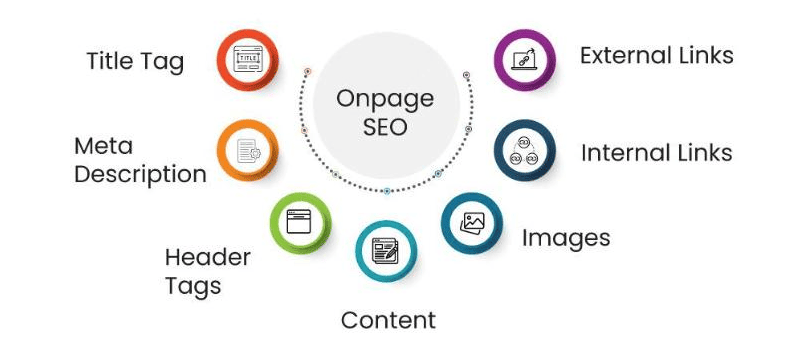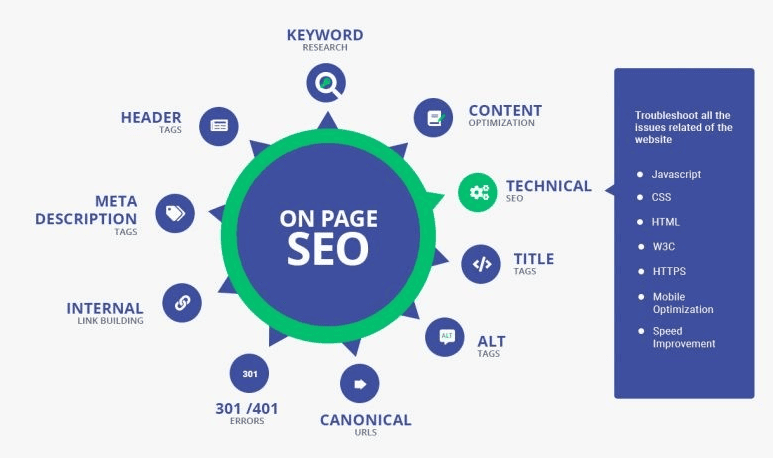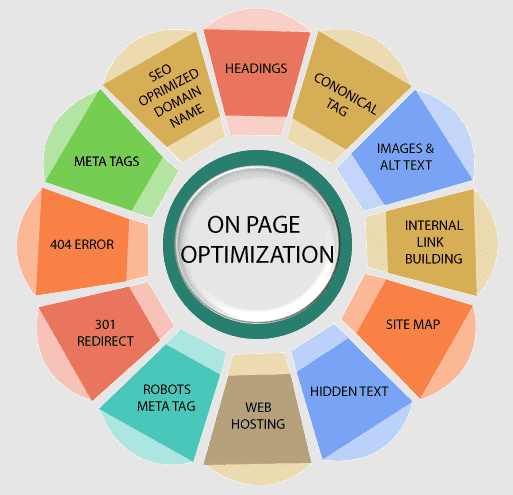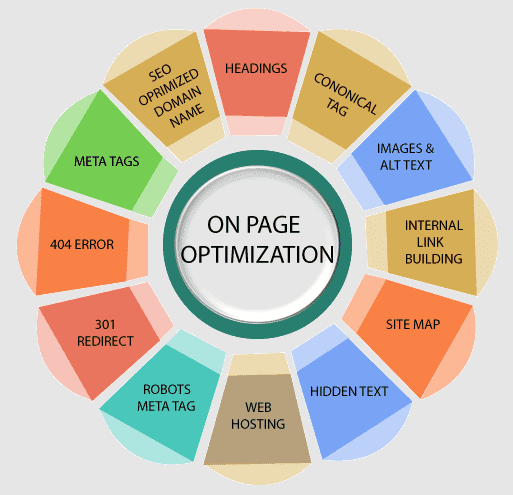how to do on page optimization in seo: Introduction
On-page optimization in search engine marketing includes optimizing personal website pages to rank higher and get more appropriate site visits in engines like Google. This contains many practices to improve the page’s content and HTML source code. Here is a detailed manual on how to perform on-web page optimization:
Title Tags
Keyword Placement:
Include the primary keyword keyword close to the beginning of the title.
Length:
Keep the title tag between 50 and 60 characters to display it fully in Look for Results.
One-of-a-kind and Descriptive:
Each website page must have a unique identity that describes the content as it should.
Meta Descriptions
Summary:
Provide a concise precis of the net page content.
Length:
Aim for 100,156 lines. This is to ensure it’s evident when seeking results.
Keywords:
Include both primary and secondary keywords.
Headings (H1, H2, H3, and so forth.)
H1 Tag:
Use one H1 tag per page. One example is the main term, which should show the page’s main topic.
Subheadings:
Use H2, H3, and so forth., for subheadings to interrupt content and make it less complicated to study. Include critical phrases where appropriate.
URL Structure
Descriptive URLs:
Create URLs that describe the website page content.
Keywords:
Include the main keywords in the URL.
Hyphens:
Use hyphens to split phrases for higher clarity and SEO.
Content Optimization
Quality Content:
Ensure the content is notable, informative, and gives value to the reader.
Keyword Usage:
Include keywords in the text and the first 100 phrases.
Length:
Long-form content usually performs higher, but make sure it’s still helpful and is not filler.
LSI Keywords:
Use Latent Semantic Indexing (LSI) key phrases to give background to your content.
Internal Linking
Relevant Links:
Link to appropriate pages inside your website to beautify user navigation and distribute website page authority.
Anchor Text:
Use descriptive and keyword-wealthy anchor textual content for internal links.
Image Optimization
Alt Text:
Provide descriptive alt textual content for all pix, like important phrases, wherein applicable.
File Names:
Use descriptive, keyword-wealthy document names for photographs.
Compression:
Compress pictures to lessen load times without giving up something nice.
Mobile-Friendliness
Responsive Design:
Ensure your website uses a responsive layout that works well on all devices.
Mobile Usability:
Use equipment like Google’s Mobile-Friendly Test to efficiently check for and connect cellular Problems.
Page Load Speed
Minimize HTTP Requests:
Reduce the number of elements on a website page to reduce HTTP requests.
Enable Compression:
Use gear like Gzip to compress files.
Optimize Code:
Minify CSS, JavaScript, and HTML.
Reduce Redirects:
Minimize the usage of redirects to make load times better.
Leverage Browser Caching:
Use browser caching to shop static sources domestically to speed up load times on repeat visits.
User Experience (UX)
Easy Navigation:
Ensure the site is to the point and has a clear format.
Readability:
Use readable fonts, the proper formatting, and a smooth format.
Engagement:
Add elements that engage customers, including movies, infographics, and interactive content.
Schema Markup
Structured Data: Use schema markup to help search engines like Google understand your content and make search better visibility with rich snippets.
Types of Markup:
Implement suitable schema types like articles, items, tasks, recipes, etc.
Social Sharing Integration
Share Buttons:
Include social sharing buttons to make it easy for users to percentage content on social media.
Metadata:
Use Open Graph and Twitter Card tags to manipulate how your content is displayed on social structures.
Security (HTTPS)
SSL Certificate:
Ensure your website uses HTTPS to encrypt data and make it more trustworthy.
Mixed Content:
Ensure all sources are loaded over to avoid problems with mixed information. HTTPS.
Analytics and Monitoring
Set Up Analytics:
Use equipment like Google Analytics and Google Search Console to monitor visitors and performance.
Track Metrics:
Monitor critical metrics, including leap fees for a regular lesson period and conversion quotes.
Regular Audits:
Do regular surveys of your search engine optimization to become aware of and connect problems.

Optimizing titles, headings, and meta descriptions
Title Tags
Title tags are vital for search engine optimization (SEO). They appear in search engine results pages (SERPs) because they are clickable headlines for a given result. They are the main thing that search engines like Google use to figure out what your website page is about.
Keyword Placement:
Primary Keyword:
Place the primary keyword close to the beginning of the identify tag. This practice facilitates serps in quickly figuring out what the page is about.
Secondary Keywords:
Include secondary important phrases if they suit naturally, but avoid keyword stuffing.
Length:
Character Limit:
Aim for fifty-60 characters. Titles longer than this could be truncated in SERPs, reducing crucial statistics.
Unique and Descriptive:
Unique Titles:
Ensure each website page has a unique name tag to avoid replicating content material problems and ensure readability.
Descriptive Content:
Write titles that as it should be describe the content material of the page, engaging users to click through.
Branding:
Brand Name:
Consider including your brand call on the top of the identify tag, space between them) or sprint (-), particularly for homepages or vital landing Brand Name”).
Meta Descriptions
Meta descriptions are HTML attributes that provide concise summaries of online pages. They appear below the name tag in SERPs and could affect click-on-via charges.
Concise Summary:
Content Overview:
Provide a brief, accurate summary of the page’s content. This should align with what customers will locate on the website page.
Call to Action:
Consider which includes a name to motion (CTA) to inspire users to click (e.g., “Learn greater,” “Find out,” “Get began”).
Length:
Character Limit:
Aim for 150-160 characters. Meta descriptions longer than this may be truncated in search effects, cutting off essential records.
Keywords:
Primary and Secondary Keywords: Naturally, use both main and secondary terms. Search engines often use strong terms in the description that answer the search question, making the result more appealing.
Unique Descriptions:
Avoid Duplicates:
Each page must have a unique meta description to prevent engines like Google from seeing your content as boring or much less relevant.
Headings (H1, H2, H3, and so forth.)
Headings organize the information on a page, making it easier for people and search engines to understand the page order and essential topics.
H1 Tag:
Main Topic:
Use an unmarried H1 tag in line with a website page that includes the primary keyword and represents the page’s leading subject matter.
Content Relevance:
The H1 must be applicable and descriptive, giving customers a clear concept of what to look forward to from the page’s information.
Subheadings (H2, H3, and so forth.):
Content structure: Use H2 tags for important parts of the content material. H3 and next tags (H4, H5, H6) may be used to smash down the content material for subsections further.
Keywords:
Naturally encompass keywords in subheadings where applicable. This allows search engines to discover the context and hierarchy of your content material.
Readability:
Good titles improve things. They are straightforward, making it easier for customers to skim and find information quickly.
Semantic HTML:
Proper Use:
Use titles that make sense. Avoid using them for styling functions. Each heading should logically notice the only earlier than it (e.g., an H3 needs to come after an H2).
Consistency:
Uniform Structure:
Follow the same direction throughout the site for a coherent consumer experience and better SEO.
Best Practices and Additional Tips
User Intent:
Match Intent:
Ensure that your titles, meta descriptions, and headings shape the user motive behind the search queries you’re targeting. Understanding consumer causes facilitates creating applicable and compelling content that meets users’ needs.
Avoid Keyword Stuffing:
Natural Integration:
Integrate key phrases evidently without overstuffing. This no longer most effectively improves readability but also avoids ability consequences from engines like Google.
A/B Testing:
Test and Optimize:
Conduct A/B tests on titles and meta descriptions to determine which versions pressure more clicks and engagement. Tools like Google Search Console can give you ideas about performance.
Tools and Resources:
Search engine marketing Tools:
Utilize search engine marketing gear like Yoast search engine marketing (for WordPress), SEMrush, Ahrefs, or Moz to get tips and test the effectiveness of your titles, meta descriptions, and headings.
Effective use of internal links
Internal linking is an essential part of on-page search engine optimization that helps search engines understand the shape of your website and presents better user enjoyment. Here’s an in-depth guide on a way to correctly use inner hyperlinks:
Understanding Internal Links
Internal hyperlinks are links that factor from one website page on a website to another on the same site. They are critical for:
Navigational Purposes:
Helping customers find associated content.
SEO Purposes:
Distribute website page authority (link juice) at some stage on the website.
Indexing:
Helping search engines like Google and Yahoo move slowly, and index pages work even better.
Planning Your Internal Linking Strategy
Site Structure:
Hierarchy:
Ensure your internet site has clarity of thought. Use a structure with the home page at the top, which can be seen through the groups., subcategories, and man or woman pages/posts.
Silo Structure:
You might want to use a silo structure to institution-related content material together, making it less complicated for users to understand the context and relevance of your content material.
Content Audit:
Identify Opportunities:
Conduct an important content audit to identify opportunities for inner linking. Look for associated content material that may be linked to charging extra fees for customers and engines like Google.
Best Practices for Internal Linking
Anchor Text:
Descriptive and Relevant:
Use descriptive anchor textual content that suggests what the linked page is about. Avoid everyday phrases like “click here.”
Keywords:
Include relevant keywords in the anchor text, but ensure they fit in with the content material to avoid over-optimization.
Link Depth:
Deep Links:
Link to deep pages (several clicks away from the homepage) to distribute hyperlink authority at some point on the site.
Avoid Overlinking:
Don’t overdo inner hyperlinks on a single web page; focus on pleasantness and relevance rather than quantity.
Contextual Links:
Within Content:
Place inner. There are links in the main text. Where they’re contextually applicable. These links are more precious than those placed in sidebars or footers.

User Experience:
Navigation:
Use inner links to improve navigation and help users find related content without problems. This enhances user enjoyment and may lessen soar charges.
Call to Action:
Use inner links as calls to action (CTAs) to take customers to essential pages like product pages, contact forms, or blog posts.
Balanced Link Distribution:
Link to Important Pages:
Ensure that your most important pages (e.g., people with excessive conversion fees) receive enough inner hyperlinks.
Avoid Orphan Pages:
Make sure every crucial website page is related from somewhere to your website page to keep away from orphan pages that search engines like Google may also leave out.
Types of Internal Links
Navigational Links:
Menus:
Use menu links to guide customers to important classes and critical pages.
Breadcrumbs:
Breadcrumb hyperlinks show the user inside the website hierarchy and provide smooth navigation.
Contextual Links:
In-Content:
Embed hyperlinks within the body of your content material to connect associated articles, blog posts, or product pages.
Footer and Sidebar Links:
Footer Links:
Include essential links, including privacy policy, touch, and popular assets.
Sidebar Links:
Use sidebar hyperlinks for associated posts, recent articles, or promotional content material.
Internal Linking Tools and Techniques
Search engine marketing Plugins and Tools:
WordPress Plugins:
Use plugins like Yoast search engine optimization or Rank Math to get internal linking recommendations and music inner link distribution.
SEO Tools:
Tools like Ahrefs, SEMrush, or Screaming Frog can help you understand inner linking opportunities and audit your present-day inner linking shape.
Manual Techniques:
Editorial Process:
Discover possibilities for linking to existing content during the content advent system. This ensures that new content is included in your internal linking approach.
Automated Tools:
Link Managers:
Use hyperlink control equipment or CMS features to automate inner linking for large sites, ensuring consistency and thorough coverage.
Monitoring and Improving Internal Links
Regular Audits:
Crawl Your Site:
Regularly move your site slowly using equipment like Screaming Frog to discover broken inner links, orphan pages, and opportunities for brand-spanking new inner links.
Fix Issues:
Promptly address damaged hyperlinks or orphan pages to maintain a wholesome internal linking shape.
Performance Tracking:
Analytics:
Use Google Analytics and Search Console to song the overall performance of your internal hyperlinks. Look at metrics that include click-thru quotes, consumer engagement, and page perspectives.
Adjust Strategy:
Based on the statistics, regulate your inner linking approach to improve consumer enjoyment and SEO performance.
User Feedback:
Heatmaps and Session Recordings:
Use gear like Hotjar or Crazy Egg to understand how users interact along with your inner hyperlinks. This can give you ideas on improving your links’ value and placement.
Best practices for on-web page search engine marketing
On-page SEO involves optimizing character internet pages to rank higher and earn more critical and relevant traffic from engines like Google. The following is content: material, HTML source code, and personal revel in its parts. Here’s an in-depth manual on the acceptable practices for on-page search engine marketing:

Crafting Effective Title Tags
Front-Load Keywords:
Start your name with the main keyword.
Keep It Concise:
Limit titles to 50-60 characters.
Uniqueness and Relevance:
Ensure each identity is specific and right away in line with the website page’s content material.
Brand Inclusion:
Consider including your name on the cease for emblem recognition.
Optimizing Meta Descriptions
Compelling Summary:
Write a short, compelling precis of the website page content.
Character Limit:
Stick to 150-160 characters.
Incorporate Keywords:
Naturally Combine the main and
Call to Action:
Include a call to movement to inspire clicks.
Utilizing Headers and Subheaders (H1, H2, H3, etc.)
Single H1 Tag:
Use one H1 tag in step with the page, centered on the number one keyword.
Hierarchical Structure:
Use H2, H3, and different tags to shape the content logically.
Keyword Usage:
Include relevant critical phrases in subheaders without forcing them.
Structuring URLs
Descriptive and Clean:
Create clean, descriptive URLs that show website page content material.
Keyword Integration:
Include the most critical keywords in the URL.
Avoid Unnecessary Parameters:
Keep URLs simple and avoid useless parameters.
Content Quality and Relevance
Value-Driven Content:
Ensure that the content material is Priced very high and addresses the user’s reason.
Keyword Placement:
Distribute key-placed sentences in the text, especially in the 100 words.
Content-Length:
I prefer long-form content that comprehensively covers the subject but avoids fluff.
Use LSI Keywords:
Integrate LSI key phrases to provide context and guide the number one topic.
Strategic Internal Linking
Relevant Contextual Links:
Link to applicable inner pages in the content material.
Descriptive Anchor Text:
Use clean, descriptive anchor textual content that includes keywords.
Balance Link Distribution:
Ensure a balanced distribution of inner links to avoid orphan pages.
Image Optimization Techniques
Descriptive Alt Text:
Write descriptive alt text for pics, which includes critical phrases wherein applicable.
Keyword-Rich File Names:
Name image files with descriptive, keyword-wealthy titles.
Image Compression:
Compress photographs to lower load times without lowering quality
Ensuring Mobile Friendliness
Responsive Design:
Implement a responsive design that adapts to special display screen sizes.
Test Mobile Usability:
Test often. Your website’s usability using tools like Google’s Mobile-Friendly Test.
Enhancing Page Load Speed
Reduce HTTP Requests:
Minimize the number of things on a page.
File Compression:
Use Gzip or similar gear to compress documents.
Optimize Code:
Minify CSS, JavaScript, and HTML to lessen report sizes.
Browser Caching:
Leverage browser caching to save static objects in the United States.
Prioritizing User Experience (UX)
Easy Navigation:
Ensure your website is simple to navigate with clean menus and internal hyperlinks.
Readable Layout:
Use readable fonts, proper formatting, and a clean layout.
Engaging Content:
Include engaging elements like videos, infographics, and interactive content.
Implementing Schema Markup
Structured Data:
Add schema markup to help search engines understand your content.
Rich Snippets:
Use schema kinds that generate wealthy snippets for better visibility in SERPs.
Integrating Social Sharing
Share Buttons:
Add social sharing buttons to make it smooth for users to percentage your content material.
Social Metadata:
Implement Open Graph and Twitter Card tags to manipulate how your content shows up on social media.
Ensuring Security with HTTPS
SSL Certificate:
Secure your internet site with an SSL certificate.
Consistent HTTPS:
Ensure all resources are stacked over HTTPS to avoid problems with mixed information.
Monitoring and Analytics
Set Up Tools:
Use Google Analytics and Search Console to display website page performance.
Track Key Metrics:
Monitor soar charge, length of meeting, and conversions.
Regular Audits:
Conduct everyday SEO studies to find out what and fix problems.
Updating and Refreshing Content
Content Freshness:
Change your content material often to hold it applicable.
Address Content Gaps:
Identify and fill content material gaps with new pages or up-to-date data.
Strategic Outbound Linking
Quality Sources:
Link to authoritative and applicable external sites.
Natural Context:
Integrate outbound of course links in the content.
Additional Tips for Effective On-Page SEO
Focus on User Intent:
Create content that aligns with the user’s search rationale.
Avoid Keyword Stuffing:
Use keywords naturally and highlight good content.
Diversify Content Types:
Use textual content, pics, videos, and other media to keep customers engaged.
Optimize for Voice Search:
Use herbal language and not strange questions to optimize voice search.
Local search engine optimization:
For agencies with bodily locations, optimize for looks close by and ensure constant NAP (Name, Address, Phone) statistics.
